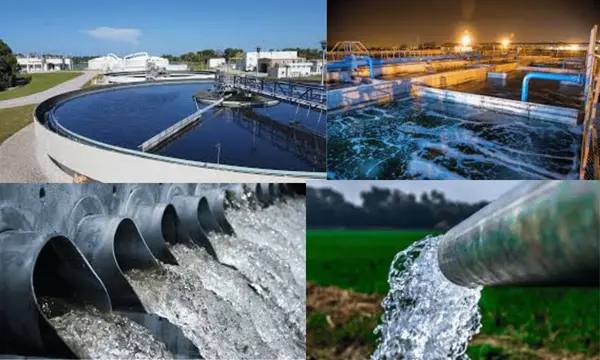Different Levels of Wastewater Treatment Process in Textile Industry
Different levels of wastewater treatment follow different methods. There are step by step or different level of wastewater treatment. It builds in the following different levels:
Different levels of wastewater treatment
- Primary level of wastewater treatment.
- Secondary level of wastewater treatment.
- Tertiary level of wastewater treatment.
- Advanced level of wastewater treatment.
Here we will discuss about the different level of wastewater treatment level by level and first of all the primary level of wastewater treatment.

Primary Level of Wastewater Treatment
After the removal of gross solids, gritty materials and excessive quantities of oil and grease need to get rid of the remaining suspended solids the maximum amount as doable. This step then move toward reducing the strength of the waste water and conjointly to facilitate secondary treatment. Primary treatment includes the subsequent separate steps as
- Screening: The Coarse suspended matters like rags, items of material, fibres, yarns and lint square measure removed. Bar screens and automatically cleansed fine screens take away most of the fibres.
- Sedimentation: Will have to removeThe suspended matter in textile effluent with efficiency and economically by alluviation. This method is especially helpful for treatment of wastes containing high proportion of settable solids or the combined treatment with waste material has to subject.
- Equalization: Effluent streams need to collect into ‘sump pit’. Generally mixed effluents are stirring by rotating agitators or by processing compressed gas from below.
- Neutralization: Ordinarily, hydrogen ion concentration values of cotton finishing effluents square measure on the alcalescent facet. Hence, hydrogen ion concentration worth of equal effluent ought to adjust.
- Chemical curdling and Mechanical flocculation: Finely divided suspended solids and mixture particles can not be with efficiency removed by easy alluviation of gravity. In such cases, mechanical activity or chemical curdling needs to utilize.
Secondary Level of Wastewater Treatment
This is another different level of wastewater treatment. The main purpose of secondary treatment is to supply organic structure removal on the far side what’s doable by easy alluviation. It conjointly removes considerable amounts of oil and phenol. In secondary treatment, the dissolved and mixture organic compounds and color gift in waste water has to remove or reduce and to stabilize the organic matter. This is achieved biologically mistreatment microorganism and different microorganisms.
These processes could also be aerobic or anaerobic. In aerobic processes, microorganism and different microorganisms consume organic matter as food. Anaerobic treatment is especially utilizable for the digestion of sludge.
The potency of this method depends upon hydrogen ion concentration, temperature, waste loading, absence of O and cyanogenic materials.
Some of the normally used biological treatment processes square measure delineated below:
Aerated lagoons
These are massive holding tanks or ponds having a depth of 3-5 m and having a line with cement, polyethylene or rubber. The effluents from primary treatment processes square measure collected in these tanks and square measure aerated with mechanical devices, like floating aerators, for regarding a pair of to six days.
During this point, it builds a healthy wool sludge, that brings regarding oxidization of the dissolving organic matter.
BOD removal to the extent of ninety nine can be achieved with economical operation.
The major disadvantages square measure the massive house needs and therefore the microorganism contamination of the lagune effluent, that necessitates additional biological purification.
Trickling filters
The trickling filters typically consists of circular or rectangular beds, 1 – 3 m deep, made with well-graded media (such as broken stone, PVC, Coal, artificial resins, Gravel or Clinkers) of size forty millimeter to a hundred and fifty millimeter.
Over that sewer water is wet uniformly on the whole bed with the assistance of a slowly rotating distributor (such as rotary sprinkler) equipped with orifices or nozzles.
The filter needs to organize in such a fashion that air will enter at the bottom counter current to the effluent flow and a natural draft has to make. A thick film, comprising of microorganism and aerobic microorganisms called “Zooglea”, on the surface of the filter medium, that thrive on the nutrients equipped by the waste water.
The organic impurities within the sewer water square measure adsorbable on the thick film throughout its passage then square measure change by the microorganism and therefore the different micro-organisms gift in this.
Activated sludge method
This is the foremost versatile biological oxidization methodology utilized for the treatment of sewer water containing dissolved solids, colloids and coarse solid organic matter.
In this method, the sewer water is aerated in a very reaction tank within which some microbic floccule is suspended.
The aerobic microorganism flora create biological degradation of the waste into greenhouse emission and water molecule, whereas intense some organic matter for synthesizing microorganism.
The microorganism flora grows and remains suspended within the kind of a floccule, that is named “Activated Sludge”.
The effluent from the reaction tank is separated from the sludge by subsidence and discharged.
A neighborhood of the sludge need to recycle to an equivalent tank to supply a good microbic population for a contemporary treatment cycle.
The surplus sludge is digestible in a very sludge autoclave, along side the first sludge from primary alluviation.
Oxidation ditch :
This can be thought-about as a modification of the standard Activated Sludge method.
Waste water, once screening is allowed into the oxidization ditch the mixed liquor containing the sludge solids is aerated within the channel with the assistance of a mechanical rotor.
The usual hydraulic retention time is twelve to twenty four hrs and for solids, it’s 20-30 days.
Most of the sludge shaped needs to recycle for the following treatment cycle. The excess sludge will dry while not odor on sand drying beds.
Tertiary Level of Wastewater Treatment
Its is another different level of wastewater treatment. It is worthy to say that the textile waste contains important quantities of non-biodegradable chemical polymers. Since the standard treatment strategies square measure inadequate, there’s the necessity for economical tertiary treatment method.
Oxidation techniques
- A variety of oxidizing agents will be as bleach out wastes. Antimicrobic decolorizes dye tub with efficiency. Tho’ it’s a coffee price technique, however it forms absorbing cyanogenic organic halides (AOX) .
- Ozone on decomposition generates O and free radicals. Therefore the later combines with coloring agents of effluent leading to the destruction of colours.
Membrane technologies
- Reverse diffusion and electrodialysis square measure the necessary samples of membrane method.
Reverse Osmosis:
- When 2 solutions having totally different concentrations, are separated by a membrane, a chemical potential can exist across membrane.
- Water can tend to diffuse through the membrane from the lower-concentration (higher potential) facet to the higher-concentration (lower-potential) facet.
- In a system having a finite volume, flow continues till the pressure distinction balances the chemical electric potential.
- This equalisation pressure distinction is termed as force per unit area. And it may be a performing matter of characteristics and concentration and temperature.
If a pressure gradient opposite within the direction and larger than the force per unit area is obligatory across the membrane, result the additional focus to the less focusing region can occur and termed as reverse diffusion.


